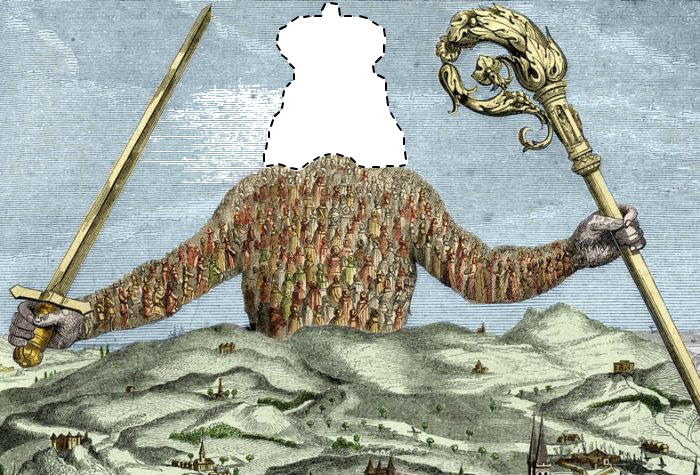By Patrick Huff
Populism of the kind displayed by the Yellow Vests is a revolt against social and ecological alienation and an affirmation of collective popular power.

Headless Leviathan. Image credit: Patrick Huff
Since the gilets jaunes (‘Yellow Vests’) erupted onto the French national stage on the 17th of November, erecting blockades and occupying roundabouts ostensibly to protest President Emanuel Macron’s new tax on fuel, the movement has evoked fears of a popular, even fascist, mob. The Yellow Vests, however, express what I call headless populism. This is not to say that, at least at the level of its internal micro-politics, the movement lacks leaders. As anyone involved in horizontal organizing will know, leadership is situational, fluid, lacks command authority, and is designated on the particular competencies of the persons at hand and the situation being confronted.
By headless populism I mean to emphasize the movement’s decentralized, horizontal, and extra-parliamentary methodology of unarmed insurrection. I also use this phrase precisely to invoke an image of a body without its head as a détournement of the classic image of the Hobbesian sovereign, a head resting on a composite body constituted by mass bodies of subjects. Of course, the headless body is also horrific, evoking bourgeois fears of a rampaging monstrous mass (and the guillotine). This symbolism of separation and dismemberment speaks finally to a reality of alienation.
I argue that alienation is a useful analytical and explanatory category through which to assess both headless and authoritarian populism, and to discern more general features of the terrain of the current political conjuncture. Indeed, alienation pervades the web of relations between the state, capital, society, and nature.
The latter category of nature is particularly relevant in general and to the specific contexts of the revolt of the Yellow Vests, as political ecologies of unarmed insurrection in the current moment must account for ecological alienation. The Yellow Vests, far from rejecting ecological concerns, have embraced them but on terms that depart from those of elite environmentalisms and reflect lived experience in which forms of social and ecological alienation intersect.
Finally, I position the struggle against alienation as a struggle for emancipation. In alienation’s negative outlines one can begin to glean the positive contours of the necessary conditions for the emancipation of both society and nature.
A dramatic insurrection
Sparked by a sense of betrayal, people began taking to the streets in protest of a policy agenda that was seemingly indifferent to concerns of everyday working people in France. As if to emphasize the social drama of their unarmed insurrection, the Yellow Vests have designated each successive sequence of the movement as an ‘act’, like the divisions of a stage play.
The move from online petitions and discussions to direct action on 17th November constituted Act I, the mass demonstrations around the country and the first eruptions of ‘violence’ in Paris on 24th November stand as Act II. The united call, on the 1st of December, for Emmanuel Macron to resign the office of president marks Act III. Act IV’s running battles with riot police suggested the intransience of the social conflict between the people and the government. Acts V and VI saw a continuation of protests around the country.
Since Macron assumed the presidency in May of 2017 he has earned the popular title of ‘president of the rich’. Macron’s televised address on 10th December seems to have done little to change this image. Speaking from behind a golden desk, he announced limited concessions but simultaneously doubled down on his commitment to restructuring the French economy on neoliberal designs. In response, 15th December saw the enactment of Act V with ongoing demonstrations and confrontations with a police force that is, by its own assessment, reaching a breaking point.
Centrism as Authoritarian Populism
Headless populism is heterogeneous, dynamic, and somewhat indeterminate. It is possible that the movement could be co-opted by far right currents or move toward the institutional left. They may simply leave the streets and go home. Thus far, however, the Yellow Vests remain headless, populist, and insurrectionary. What they are rising against is the alienation affected by Macron’s authoritarian populism in its neoliberal centrist mode.
Stuart Hall’s (1998) prescient essay The Great Moving Nowhere Show is instructive in this regard. Commenting on the rise of New Labour’s Third Way in Britain, Hall observes that, ‘this is not the populism of Mrs. Thatcher’s neoliberal right, but it is a variant species of “authoritarian populism” nonetheless — corporate and managerialist in its “downward” leadership style and its moralizing attitude to those to whom good is being done’ (p. 13). This ‘variant species’ has since come to dominate the political landscape across the North Atlantic world. It may seem strange to think of centrism as a variant of authoritarian populism but that is a measure of its success as a hegemonic strategy.
Before he was delivering speeches from the Élysée Palace, Macron’s campaign rhetoric positioned him as a youthful anti-establishment outsider critical of the staid elite. At one point he even proclaimed, without a hint of irony, that, ‘France is blocked by the self-serving tendencies of its elite’, to supporters at a rally in the southern town of Pau. ‘And I’ll tell you a little secret’, he added, lowering his voice: ‘I know it, I was part of it’.
Populism is a form of hegemonic strategy that, in its appearance of inclusivity, takes on contradictory elements. Neoliberal centrists, for instance, used the rhetoric of market efficiency, opportunity, and shared prosperity as rationales for their ‘reform’ agenda. Thirty years on, however, the real success of institutional ‘reforms’ has undermined its justifying narrative. As Mark Fisher observed, ‘…the result of imposing “marketization” on public services is always a crazed proliferation of bureaucracy, via target setting, league tables, performance reviews, etc.’. Fisher notes that under these conditions, ‘…everything becomes geared toward the production of appearance.’
Centrism’s branding projects an image of a broadly inclusive and pragmatic political center, girded in its extreme margins by the far right and left. Branding, of course, is just another word for propaganda. In reality centrism represents an increasingly exclusive and narrow elite neoliberal consensus. The social consequence of all this is a mounting, multidimensional and intersectional crisis of alienation.

‘Down with caviar, long live kebab’. Source: facebook.com/jacobinmag
The ‘scream’ of alienation announces hegemonic crisis
Alienation is a material force, a structure of relations, of political, economic, social, and ecological estrangement. As lived experience, alienation is simultaneously subjective and objective. John Holloway’s notion of ‘the scream’, his conceptual analog for alienation, with its embodied affective materiality and its connotations of both anguish and revolt, suggests the role of rejecting alienation in piercing hegemonic appearances.
As its objective conditions proliferate across the social body and the scream of alienation grows in intensity, the reality of actually existing centrism precipitates its own crisis of legitimacy. The significance of acknowledging this is twofold. Alienation is not only explanatory of the crisis but it also points toward a resolution in its intimation of a potential politics, with movements like the Yellow Vests we might say a ‘becoming politics.’
Since at least 2011 this ‘scream’ has been expressed in a worldwide series of social revolts. The submission of governments and civil society institutions to neoliberalism’s tenets has left disruptive headless populism as one of the few remaining substantive avenues of popular dissent and outrage. On one level what we are seeing is the proliferation of strategies and tactics developed in the heat of anarchist, autonomist, and feminist struggles.
Occupy Wall Street and the Movements of the Squares in Europe might be seen as inaugurating the current wave of struggles. But if Occupy saw the proliferation of the logic of assembly and consensus, the Yellow Vests might be understood as what it looks like when black bloc tactics go mainstream. All this suggests that we are in the midst of a generalized hegemonic crisis, a Gramscian interregnum.
The political ecology of alienation
As neoliberal subjects the Yellow Vests were certainly positioned by the political establishment as ‘those to whom good is being done’, to use Hall’s biting phrase. This is a reason why their unarmed insurrection seemed so confusing to the establishment commentariat. As Macron maintained, even during his concessional address, eliminating the solidarity tax on the ultra-wealthy was appropriate and necessary to create jobs and raising the fuel tax was required for France’s ‘green transition’ to a sustainable economy.
Critics have pointed to the fuel tax’s green justification and its rejection by the Yellow Vests as a telling demonstration of the movement’s politically regressive and anti-environmental character. At a more general level this implied a dichotomy between the needs and desires of the working class and the need for sustainable environment policy. But this is a false dichotomy and a mischaracterization of the general thrust of the movement. The movement readily acknowledges the need for a transition to a low-carbon economy and they have issued a communiqué speaking specifically to ecological concerns.
Far from signaling an impassible dichotomy, the Yellow Vests appear to see social justice and ecological sustainability as not only congruent but essential to a just transition. In a general sense what the Yellow Vests have demonstrated is that the political crisis is an economic crisis. The economic crisis is the ecological crisis. The ecological crisis is the political crisis. At the core of these intersectional crises is political, economic, and ecological alienation.
Conclusion
Alienation is the result of the collective dispossession of people from their creative powers and potentials. Headless populism of the kind displayed by the Yellow Vests is a revolt against this dispossession and an affirmation of collective popular power; it points in an emancipatory direction with its participatory and directly democratic means and ends.
To say this is not to make the naïve claim that the Yellow Vests represent some unmitigated good or that they are somehow free of the accumulated socio-historical baggage of nationalism, chauvinism, or other social maladies. All mass movements are constituted by historically situated actors. The question is not whether such movements are born pure, but whether or not they might, to one degree or another, exceed their historical conditioning. Such movements suggest that even at this late hour the future is still open to be claimed.
This is the second of a series of posts on Authoritarianism, populism and political ecology, co-organised by the STEPS Centre and the ENTITLE Collective.
Patrick Huff is an Associate Lecturer in Birkbeck’s Department of Geography, Environment and Development Studies.


Reblogged this on POLLEN.